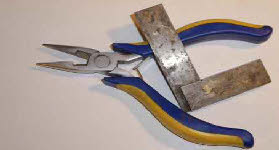


Why don’t they uncouple?
I think it’s much more difficult to work out why vehicles don’t uncouple, and it can have a number of causes:
- unequal buffer lengths resulting in lack of clearance from the buffer heads to the tail of the coupling as described above
- lower leg of coupling at wrong angle (too flat) which prevents the couplings sliding over each other to uncouple
- burrs on the lower tip of the coupling
- insufficient downward movement (possibly not enough clearance over the axle)
- couplings not dead centre horizontally, and pressing side-to-side against each other, so more force required to pull down
- dropper not long enough
- dropper not vertical, so pulls down at an angle, pressing against the other coupling, and creating too much resistance
- problems with electromagnets - (more on this topic below).
Having said all of that, it is difficult to put electromagnets at every location where you might wish to uncouple, so I quite often resort to manual uncoupling if necessary.
Why do they uncouple when they shouldn’t?
Theoretically, AJ’s shouldn’t uncouple when in tension (ie being pulled). However, I find that sometimes they do. This can be quite puzzling (not to mention incredibly irritating!) but I think it comes down to incorrect height or horizontal adjustment, and a loco which doesn’t run smoothly. If the loco falters slightly, the couplings are no longer in tension, and may therefore uncouple if the AJ’s are not correctly positioned’ particularly I think, if there is too much sideplay in the axles.
I’ve also noticed recently that if the first bend on the AJ (the 180 deg bend) is not quite tight, then the couplings can lock together and may then spring apart (and uncouple) if the loco falters, and the couplings are momentarily not in tension.
The AJs may also inadvertently couple up (when being pushed after uncoupling) if the loco falters slightly and then ‘catches up’ with its train. Similarly, if the baseboards are not quite level, or the wagons run very freely, the wagons may run away and then recouple when they buffer up again. I’m not sure what can be done about this, apart from the obvious - perfect locos, clean track and level baseboards.
Couplings on bogie stock
I’m not sure anybody has really resolved the issue of couplings on bogie stock. The two essential problems to me are firstly that it is difficult to get the correct length of AJ (ie long enough to bend when pulled down by the electromagnet), and secondly it’s very difficult to make sure that the AJ is central to the coach, and properly aligned - do you attach it to the bogie, or the coach itself? If the latter, there is a lot of overhang on bogie coaches which might cause problems on bends, and if the former, the short wheel-base of the bogie make it tricky to keep the AJ aligned with the buffers.
I have to say that with Brighton Road, the passenger trains run end-to-end, so there is no need to uncouple the coaches, apart from uncoupling/coupling the loco in the fiddle yards. I’ve therefore resorted to short AJs fitted to the outer end of the bogies, and without armatures. In general, only the ends of the rakes of coaches have AJs, and all the other couplings are screw-link or similar. All my wagon and coaching stock travels on cassettes in boxes, so remains coupled all the time.
Electromagnets
I am certainly not an expert on designing electromagnets, and I am surprised by how little information there is available on the web. All I was able to find was a spreadsheet from an American site which used imperial dimensions and American standard wire gauge (which is not quite the same as British swg).
The electromagnets used on Brighton Road were bought at least 20 years ago, from a member of a model railway club who made each one by hand. They were originally intended for Pulborough, but never got fitted. They consist of a coil of 33swg wire approximately 22mm diameter and 12mm deep, with a core of a 100mm wire nail (about 4mm diameter).
Putting these dimensions into the spreadsheet, using the nearest awg, suggests that there are about 1500 turns, a resistance of 25 ohms, and a current draw of 0.65 amps at the recommended 15 volts. I tried modifying the dimensions using the spreadsheet, to increase the strength of the magnets, which is principally a function of current (which is dependent on voltage and coil resistance) and the number of turns in the coil. The shape of the coil (short/fat or long/thin) is also a factor, but of much less significance.
- Increasing the diameter of the wire increases the current, but reduces the number of turns - with a more or less neutral effect.
- Increasing the number of turns reduces the current - again with little effect
- The only material change comes with an increase in the voltage. However, this also increases the current drawn, so it seems the best option is to increase both number of turns, and voltage (by approximately the same percentage) and this will keep the current drawn more-or-less the same, whilst increasing the strength of the magnet.
I have actually used a voltage of 21V DC for these magnets,to increase their power - but they do get a bit hot after a few seconds.
I think it’s much more difficult to work out why vehicles don’t uncouple, and it can have a number of causes:
-
Having said all of that, it is difficult to put electromagnets at every location where you might wish to uncouple, so I quite often resort to manual uncoupling if necessary.
Why do they uncouple when they shouldn’t?
Theoretically, AJ’s shouldn’t uncouple when in tension (ie being pulled). However, I find that sometimes they do. This can be quite puzzling (not to mention incredibly irritating!) but I think it comes down to incorrect height or horizontal adjustment, and a loco which doesn’t run smoothly. If the loco falters slightly, the couplings are no longer in tension, and may therefore uncouple if the AJ’s are not correctly positioned’ particularly I think, if there is too much sideplay in the axles.
I’ve also noticed recently that if the first bend on the AJ (the 180 deg bend) is not quite tight, then the couplings can lock together and may then spring apart (and uncouple) if the loco falters, and the couplings are momentarily not in tension.
The AJs may also inadvertently couple up (when being pushed after uncoupling) if the loco falters slightly and then ‘catches up’ with its train. Similarly, if the baseboards are not quite level, or the wagons run very freely, the wagons may run away and then recouple when they buffer up again. I’m not sure what can be done about this, apart from the obvious -
Couplings on bogie stock
I’m not sure anybody has really resolved the issue of couplings on bogie stock. The two essential problems to me are firstly that it is difficult to get the correct length of AJ (ie long enough to bend when pulled down by the electromagnet), and secondly it’s very difficult to make sure that the AJ is central to the coach, and properly aligned -
I have to say that with Brighton Road, the passenger trains run end-
Electromagnets
I am certainly not an expert on designing electromagnets, and I am surprised by how little information there is available on the web. All I was able to find was a spreadsheet from an American site which used imperial dimensions and American standard wire gauge (which is not quite the same as British swg).
The electromagnets used on Brighton Road were bought at least 20 years ago, from a member of a model railway club who made each one by hand. They were originally intended for Pulborough, but never got fitted. They consist of a coil of 33swg wire approximately 22mm diameter and 12mm deep, with a core of a 100mm wire nail (about 4mm diameter).
Putting these dimensions into the spreadsheet, using the nearest awg, suggests that there are about 1500 turns, a resistance of 25 ohms, and a current draw of 0.65 amps at the recommended 15 volts. I tried modifying the dimensions using the spreadsheet, to increase the strength of the magnets, which is principally a function of current (which is dependent on voltage and coil resistance) and the number of turns in the coil. The shape of the coil (short/fat or long/thin) is also a factor, but of much less significance.
-
I have actually used a voltage of 21V DC for these magnets,to increase their power -